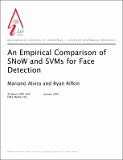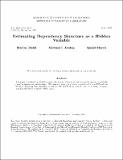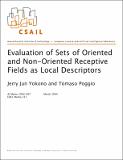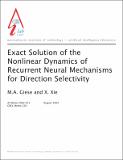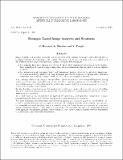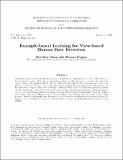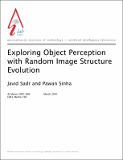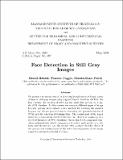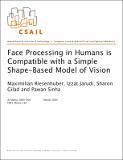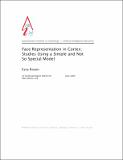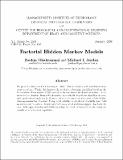Browsing CBCL Memos (1993 - 2004) by Title
Now showing items 21-40 of 123
-
An Electronic Market-Maker
(2001-04-17)This paper presents an adaptive learning model for market-making under the reinforcement learning framework. Reinforcement learning is a learning technique in which agents aim to maximize the long-term accumulated rewards. ... -
An Empirical Comparison of SNoW and SVMs for Face Detection
(2001-01-01)Impressive claims have been made for the performance of the SNoW algorithm on face detection tasks by Yang et. al. [7]. In particular, by looking at both their results and those of Heisele et. al. [3], one could infer that ... -
An Equivalence Between Sparse Approximation and Support Vector Machines
(1997-05-01)In the first part of this paper we show a similarity between the principle of Structural Risk Minimization Principle (SRM) (Vapnik, 1982) and the idea of Sparse Approximation, as defined in (Chen, Donoho and Saunders, ... -
Estimating Dependency Structure as a Hidden Variable
(1998-09-01)This paper introduces a probability model, the mixture of trees that can account for sparse, dynamically changing dependence relationships. We present a family of efficient algorithms that use EM and the Minimum Spanning ... -
Estimating Dependency Structure as a Hidden Variable
(1997-06-01)This paper introduces a probability model, the mixture of trees that can account for sparse, dynamically changing dependence relationships. We present a family of efficient algorithms that use EMand the Minimum Spanning ... -
Evaluation of sets of oriented and non-oriented receptive fields as local descriptors
(2004-03-24)Local descriptors are increasingly used for the task of object recognition because of their perceived robustness with respect to occlusions and to global geometrical deformations. We propose a performance criterion for a ... -
Exact Solution of the Nonlinear Dynamics of Recurrent Neural Mechanisms for Direction Selectivity
(2002-08-01)Different theoretical models have tried to investigate the feasibility of recurrent neural mechanisms for achieving direction selectivity in the visual cortex. The mathematical analysis of such models has been restricted ... -
Example Based Image Analysis and Synthesis
(1993-11-01)Image analysis and graphics synthesis can be achieved with learning techniques using directly image examples without physically-based, 3D models. In our technique: -- the mapping from novel images to a vector of "pose" ... -
Example Based Learning for View-Based Human Face Detection
(1995-01-24)We present an example-based learning approach for locating vertical frontal views of human faces in complex scenes. The technique models the distribution of human face patterns by means of a few view-based "face'' and ... -
Experimental Markets for Product Concepts
(2001-07-01)Market prices are well known to efficiently collect and aggregate diverse information regarding the value of commodities and assets. The role of markets has been particularly suitable to pricing financial securities. This ... -
Exploring Object Perception with Random Image Structure Evolution
(2001-03-01)We have developed a technique called RISE (Random Image Structure Evolution), by which one may systematically sample continuous paths in a high-dimensional image space. A basic RISE sequence depicts the evolution of an ... -
Face Detection in Still Gray Images
(2000-05-01)We present a trainable system for detecting frontal and near-frontal views of faces in still gray images using Support Vector Machines (SVMs). We first consider the problem of detecting the whole face pattern by a single ... -
Face processing in humans is compatible with a simple shape-based model of vision
(2004-03-05)Understanding how the human visual system recognizes objects is one of the key challenges in neuroscience. Inspired by a large body of physiological evidence (Felleman and Van Essen, 1991; Hubel and Wiesel, 1962; Livingstone ... -
Face Representation in Cortex: Studies Using a Simple and Not So Special Model
(2003-06-05)The face inversion effect has been widely documented as an effect of the uniqueness of face processing. Using a computational model, we show that the face inversion effect is a byproduct of expertise with respect to the ... -
Factorial Hidden Markov Models
(1996-02-09)We present a framework for learning in hidden Markov models with distributed state representations. Within this framework, we derive a learning algorithm based on the Expectation--Maximization (EM) procedure for maximum ... -
Fast Learning by Bounding Likelihoods in Sigmoid Type Belief Networks
(1996-02-09)Sigmoid type belief networks, a class of probabilistic neural networks, provide a natural framework for compactly representing probabilistic information in a variety of unsupervised and supervised learning problems. ... -
Fast Object Recognition in Noisy Images Using Simulated Annealing
(1995-01-25)A fast simulated annealing algorithm is developed for automatic object recognition. The normalized correlation coefficient is used as a measure of the match between a hypothesized object and an image. Templates are ... -
Feature Selection for Face Detection
(2000-09-01)We present a new method to select features for a face detection system using Support Vector Machines (SVMs). In the first step we reduce the dimensionality of the input space by projecting the data into a subset of ... -
Forecasting Global Temperature Variations by Neural Networks
(1994-08-01)Global temperature variations between 1861 and 1984 are forecast usingsregularization networks, multilayer perceptrons and linearsautoregression. The regularization network, optimized by stochasticsgradient descent associated ... -
A Formulation for Active Learning with Applications to Object Detection
(1996-06-06)We discuss a formulation for active example selection for function learning problems. This formulation is obtained by adapting Fedorov's optimal experiment design to the learning problem. We specifically show how to ...

